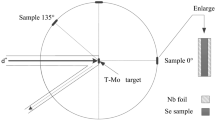Abstract
Experiments aimed at detecting and investigating neutron resonances in the \(^{178m_2 } Hf\) isomer are described, and the results obtained in these experiments are presented. The investigations in question are of great interest since the structure of this isomer—it is interpreted as the (π7/2+, π9/2+, ν7/2+, ν9/2+) configuration—and its high spin of J=16 differ significantly from the structure and spin of nuclei studied previously. The experiments performed at the Kurchatov Institute employed a neutron source based on the FAKEL linear electron accelerator and a multisection detector from NaI(Tl) crystals that was able to ensure a 4π coverage. This equipment made it possible to study gamma-ray cascades in radiative neutron capture versus neutron energy. Despite an extremely small number of isomer nuclei, a low content of the isomer in the target used, and its high radioactivity, resonances were discovered that arise upon neutron capture by a high-spin \(^{178m_2 } Hf\) nucleus. The parameters of these resonances were found. The mean spacing between the revealed resonances is about 1 eV, which is consistent with calculations based on the Fermi gas model. This indicates that the Fermi gas model describes well the density of both low-and high-spin levels. At the same time, the above agreement suggests that, upon the formation of a compound nucleus, the structure of the isomeric state is destroyed completely. On the other hand, glaring discrepancies between experimental data and the predictions of the statistical model were found: gamma transitions from high-spin resonances (J=31/2+, 33/2+) populate predominantly the low-spin ground state (J=9/2+) rather than the high-spin state of the \(^{178m_2 } Hf\) isomer (J=25/2−); the radiative width is approximately one-third as great as that which is predicted by the statistical model; and the properties of gamma cascades are different for different resonances, this difference being beyond statistical fluctuations. The results of the present investigation make it possible to reveal special features in the behavior of the quantum number K at high excitation energies.
Similar content being viewed by others
References
I. V. Kurchatov, B. V. Kurchatov, L. V. Mysovsky, and L. I. Rusinov, C. R. He. Acad. Sci. 200, 1201 (1935).
V. G. Soloviev, Theory of Complex Nuclei (Pergamon, Oxford, 1976), p. 149.
S. F. Mughabghab, in Neutron Cross Sections Series, Vol. 1: Neutron Resonance Parameters and Thermal Cross Sections (Academic, New York, 1984).
Yu. Ts. Oganessian et al., J. Phys. G 17, 393 (1991).
Yu. Ts. Oganessian et al., in Proceedings of the Workshop on Application of Lasers in Atomic Nuclear Research, Dubna, 1990, D15-91-410, p. 55.
G. V. Muradian et al., Nucl. Sci. Eng. 90, 60 (1985).
G. V. Muradian et al., in Proceedings of the 2nd International Seminar on Interaction of Neutrons with Nuclei (ISINN-2), Dubna, Russia, 1994, E3-94-419, p. 214.
Yu. Ts. Oganessian et al., in Proceedings of International Conference “Nuclear Physics of Our Times,” Sunnybell Island, Florida, 1992.
G. V. Muradian et al., Nucl. Instrum. Methods Phys. Res. A 411, 396 (1998).
G. V. Muradian and Yu. V. Adamchuk, Nucl. Phys. 68, 549 (1965).
Yu. V. Sokolov, Level Density in Nuclei (Énergoatomizdat, Moscow, 1990).
A. Gilbert and A. G. W. Cameron, Can. J. Phys. 43, 1446 (1965).
A. V. Ignatyuk, Yad. Fiz. 17, 502 (1973) [Sov. J. Nucl. Phys. 17, 258 (1973)].
Reference Input Parameter Library (IAEA, Vienna, 1997).
J. Kopecky and R. E. Chrien, Nucl. Phys. A 468, 285 (1987).
M. Uhl and J. Kopecky, Report INDC(NDS)-335, IAEA (Vienna, 1995), p. 157.
Ch. Briançon et al., in Proceedings of the 8th International Symposium “Capture γ-ray Spectroscopy and Related Topics,” Fribourg, 1993, Ed. by J. Kern (World Sci., Singapore, 1993), p. 192.
Author information
Authors and Affiliations
Additional information
__________
Translated from Yadernaya Fizika, Vol. 66, No. 1, 2003, pp. 8–18.
Original Russian Text Copyright © 2003 by Muradian, Shatrov, Voskanian, Yastrebova, Volkov, Briançon, Hussonnois, Oganessian, Karamian, Constantinescu.
Rights and permissions
About this article
Cite this article
Muradian, G.V., Shatrov, O.Y., Voskanian, M.A. et al. Search for neutron resonances in the \(^{178m_2 } Hf\) isomer and their investigation. Phys. Atom. Nuclei 66, 6–16 (2003). https://doi.org/10.1134/1.1540652
Received:
Issue Date:
DOI: https://doi.org/10.1134/1.1540652




